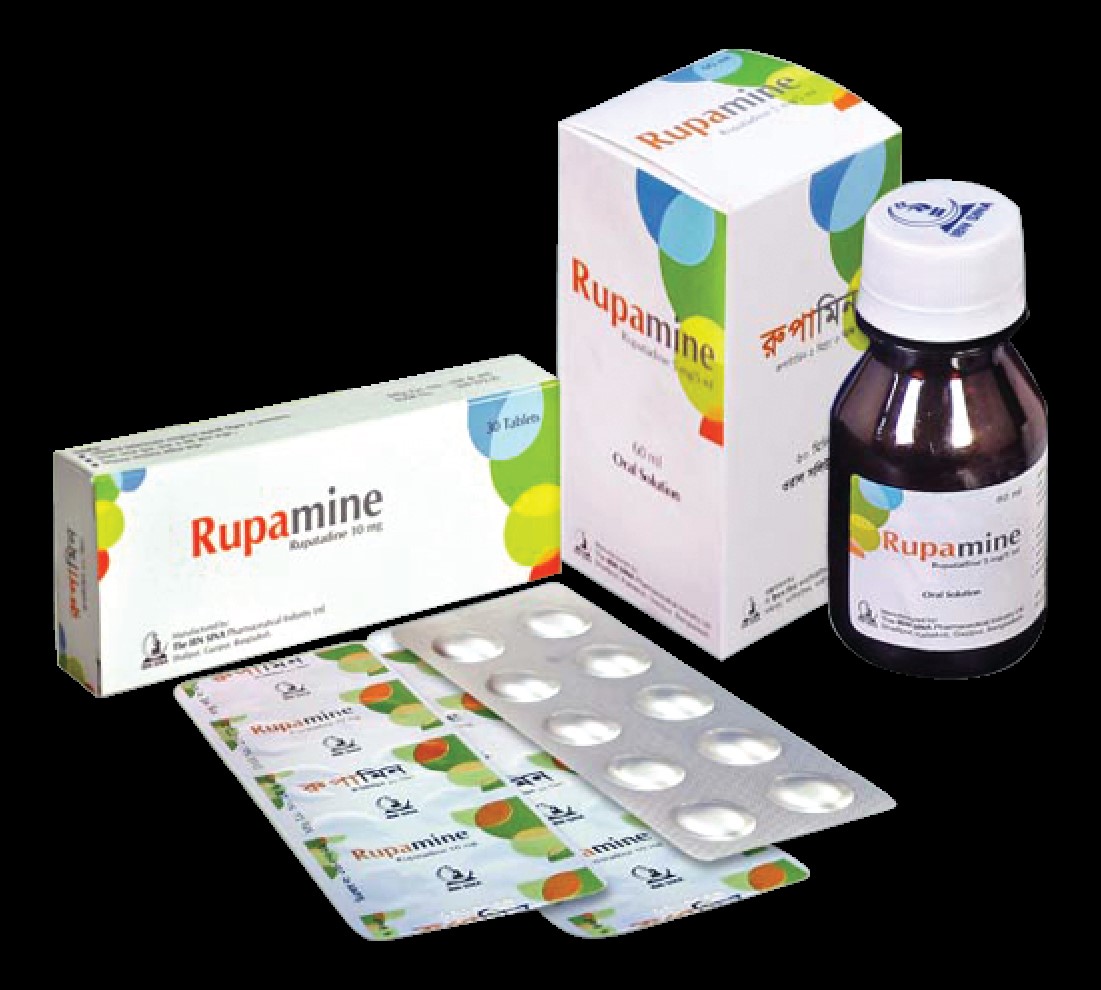
RUPAMINE
RUPATADINE FUMERATE INN
| NAME | STRENGTH | PACK SIZE | DOSAGE FORM |
|---|---|---|---|
| RUPAMINE 10 MG | 10 MG | 30 S | TABLET |
| RUPAMINE 5 MG/5 ML | 5 MG/5 ML | 60ML | ORAL SOLUTION |
Rupamine Tablet: Each tablet contains Rupatadine fumarate INN equivalent to Rupatadine 10 mg. Rupamine oral solution: Each 5 ml oral solution contains Rupatadine Fumarate INN equivalent to Rupatadine 5 mg.
Rupatadine is a long-acting, non-sedative antagonist of histamine H1receptors. It also antagonizes the platelet-activating factor (PAF). Both histamine and PAF cause bronchoconstriction which leads to an increase in the vascular permeability and act as a mediator in the inflammatory process. With the dual mode of action, Rupatadine shows better therapeutic effect than an isolated antihistamine. Rupatadine possesses other anti-allergic properties such as the inhibition of the degranulation of mast cells induced by immunological and non-immunological stimuli and inhibition of the release of cytokines, particularly of the tumor necrosis factor alpha (TNFa) in human mastocytes and monocytes.
Rupatadine is indicated for the symptomatic treatment of seasonal & perennial allergic rhinitis and urticaria.
Adults and adolescents (above 12 years): The recommended dosage is 10 mg once daily. Children aged 2 to 11 years: Children weighing 25 kg or more: 5 ml (5 mg of Rupatadine) of oral solution once a day. Children weighing equal or more than 10 kg to less than 25 kg: 2.5 ml of oral solution once a day. Rupamine can be taken with or without food.
Hypersensitivity to Rupatadine or to any of the excipients.
Administration of a dose of 10 mg daily of Rupatadine has not shown significant effects on the function of the central nervous system as seen in specific studies done for psychomotor function. Nevertheless, the patient should take precaution in driving or managing machines. Use of Rupatadine is not recommended in patients with renal or hepatic insufficiency, as no relevant clinical data is available.
The most common undesirable effects are sleepiness, general weakness & fatigue. Other uncommon undesirable effects include, dyspepsia, rash and increased appetite.
There is no clinical data available on the exposure of Rupatadine during pregnancy. Studies in animals did not show direct or indirect damaging effects, which refer to the pregnancy, embryonic/fetal development, delivery or pre-natal development. Pregnant women should therefore not use Rupatadine, unless the potential benefit outweighs the potential risk for the fetus. No information is available, whether Rupatadine is excreted in the mother's milk. Therefore, it should not be used during lactation, unless the potential benefits for the mother justify the potential risk to the infant.
Neither the safety nor the efficacy of Rupatadine has been established in patients less than 2 years of age.
CYP3A4 inhibitors like Erythromycin & Ketoconazole inhibits both the presystemic and systemic metabolism of Rupatadine. Due to this potential interaction, it is not recommended to use Rupatadine in combination with Ketoconazole, macrolides or any other inhibitors of CYP3A4. Co administration of Rupatadine and CNS depressants or alcohol may increase CNS depressant effect.
No case of overdose has been reported. In a clinical safety study Rupatadine at daily dose of 100 mg during 6 days was well tolerated. The most common adverse reaction was somnolence. If accidental ingestion of very high doses occurs symptomatic treatment together with the required supportive measures should be given.
Store in cool and dry place (below 30°C), protect from light. Keep out of reach of children.
Rupamine Tablet: Each box containing 3×10 tablets. Rupamine oral solution: Each bottle contains 60 ml solution with a measuring spoon.
